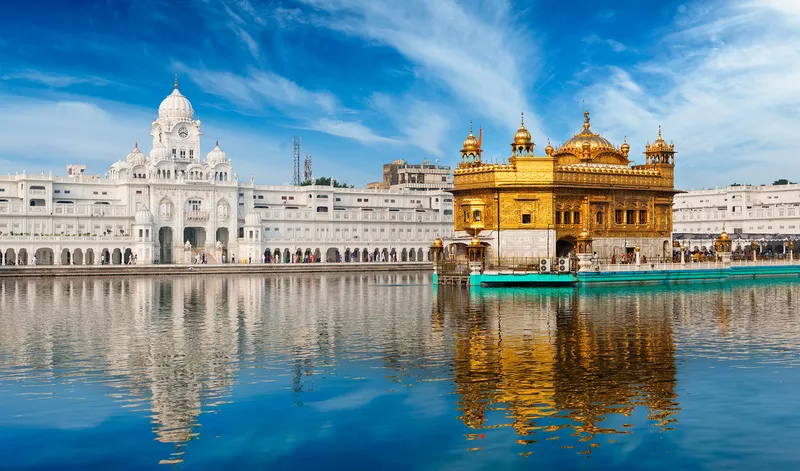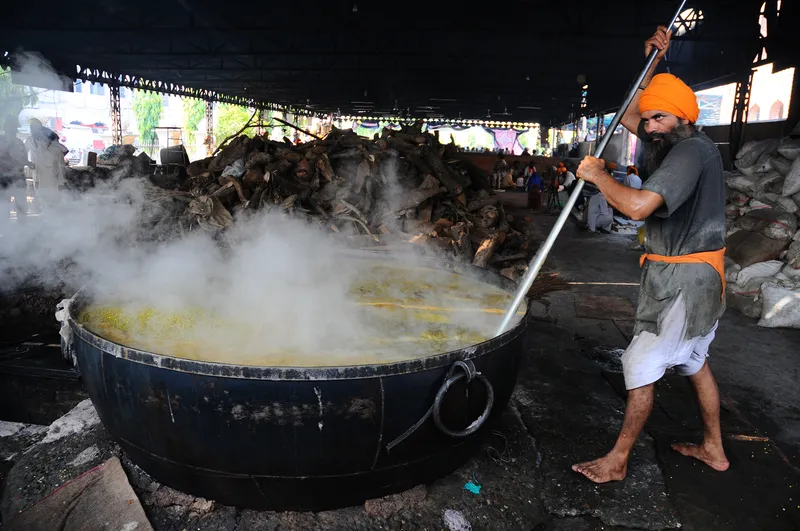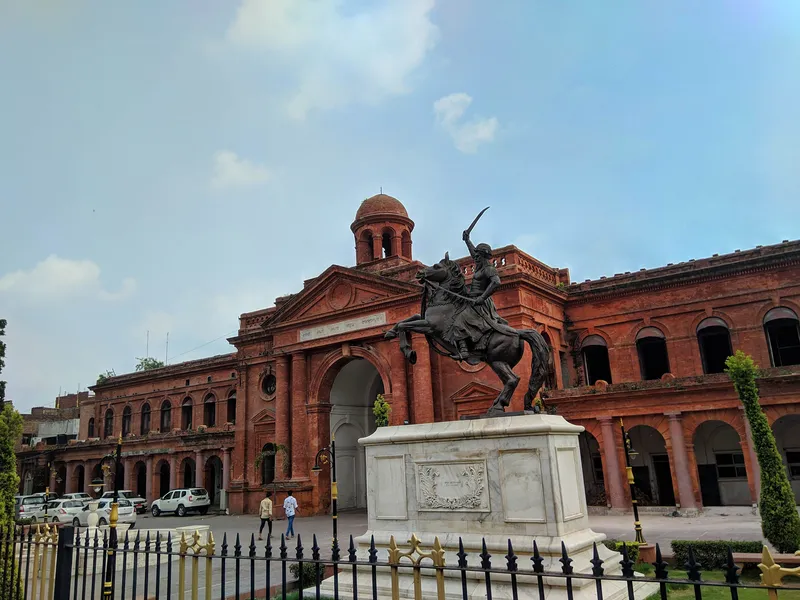Amritsar: The city that’s made selfless service its calling card
Seva is a way of life in Amritsar. This spirit is exemplified at Harmandir Sahib–the beating heart of the city–where there’s always a meal for everyone, and where people staunchly believe service is love.
“This is a city like no other, Bibi. Help’s always at hand, and no one ever goes hungry,” the taxi driver tells us.
“In the city home to Harmandir Sahib (Golden Temple), people are joyous, thankful, and helpful,” adds Deep Singh, whose turban is colour-coordinated with his shirt, adding a cheery touch to his joyful nature.
As we spent a day in Amritsar, we discovered the generosity and spirit of the people of the city, which Singh speaks so fondly of.
It’s morning, and the family is making its way to the Golden Temple–the pre-eminent spiritual site of Sikhism. Outside the car, a heavy fog bears down, making visibility difficult; Singh, however, seems to have superpowers and navigates the road fearlessly.
Founded in 1577 by Guru Ram Das, the fourth Sikh guru, Amritsar is the second largest city in the northern state of Punjab, with Harmandir Sahib its beating heart.
We’re worried that the fog will hinder our darshan, but it lifts just for a moment as we enter the complex to give us an eyeful of the legendary Golden Temple, one of India’s most tranquil and humbling sights.
Located in the centre of Amrit Sarovar, a man-made tank excavated in the time of Guru Ram Das, and reached by walking over a long marble causeway, the Golden Temple blends Hindu and Islamic architectural styles.
Built on a 67-ft square of marble, the structure is two-storeyed; the elegant lower level made of marble showcases flower and animal motifs in pietra dura (mosaic) work; the glittering second level, encased in intricately carved gold panels, is topped by a dome gilded with 750kg of gold. The tank is said to have healing powers, with pilgrims from across the world coming to bathe in its sacred waters.

The Golden Temple is more than a religious site; it's a symbol of human brotherhood and equality. Photo: Shutterstock
“The first gurdwara here was built by Arjan, the fifth Sikh guru, who symbolically placed it on a lower level so that everyone—from the rich to the poor—had to step down to enter. Entrances were made on all four sides, indicating that the gurdwara was open to worshippers of all castes and creeds,” Singh says.
The temple was destroyed several times by Afghan invaders and was rebuilt by Maharaja Ranjit Singh, who founded the Sikh empire. He adorned the lower storey with white marble inlaid with designs and the interior walls with frescoes and gold leaf decorations in 1809. The sanctum was overlaid with gold leaf in 1830.
Facing the entrance to the causeway is the Akal Takht–the ‘throne of the timeless one’–the chief centre of authority of Sikhism and the headquarters of the Shiromani Akali Dal, the main political party of the Sikhs in Punjab.
“The Golden Temple is one of the holiest sites for Sikhs, just like Gurdwara Janam Asthan in Nankana Sahib and Gurdwara Darbar Sahib in Kartarpur,” Singh says.
The melodious sound of the Gurbani, resonant hymns sung aloud by devotees, accompanies us as we circumambulate the temple. The kirtan begins early every morning when the doors of the Akal Takht, where the Guru Granth Sahib rests each night, open. It continues nonstop as the sacred book, also known as the Adi Granth, is brought into the sanctum sanctorum and then returned to the Akal Takht at night.
We partake of the steaming hot, golden kada prasad–halwa rich in ghee and dried fruits. The prasad has deep symbolic and spiritual significance for the Sikhs.

The huge kitchens at Golden Temple are serviced by Sikh volunteers doing seva. Photo: Shutterstock
“It represents the grace and blessings of god. The act of preparing and sharing it fosters equality, unity, and selfless service within the community,” Singh says.
Amritsar, a city that has been ravaged by turbulence in the past, is known for its magnanimity, benevolence, and altruism in the present. The fulfilment of seva is a part of life here.
“Seva means selfless service, and in Sikhism it is not just an exhortation and a guide but a daily practice,” writes Jasreen Mayal Khanna in her book Seva: Sikh Wisdom for Living Well by Doing Good. “Kind has been cool among Sikhs way before it became a Brooklyn hipster motto.”
I see it in the people helping out where they can—sweeping the premises, mopping wet floors, stirring ingredients in large vats, and serving food at the langar.
In the city where no one ever goes hungry, a hot meal is always available at the langar, a free, communal kitchen that serves 100,000 people per day, every day. Anyone can sit down for a basic meal—dal, chole, chapatis, and yoghurt served on a stainless steel plate—at any hour of the day, and return to eat here, without discrimination, for as long as they need.

On holidays and religious occasions, the Golden Temple langar serves more than 100,000 people. Photo: Shutterstock
Amritsar’s generosity of spirit seems to have only grown in the face of turbulence and tumult.
The mayhem of the past comes to the fore at the nearby Jallianwala Bagh, now a memorial of national importance. On April 13, 1919, British troops under the command of General Reginald “Rex” Dyer gunned down protesters at the garden, killing up to 1,500 people.
UK Prime Minister Winston Churchill later described the massacre to the House of Commons as a “slaughter”, a “monstrous event” and “an episode without precedent or parallel in the modern history of the British Empire”.
The entrance to Jallianwala Bagh, a narrow passage, brings to mind the fact that this was the only entry and exit point and was occupied by Dyer's troops when they opened fire.
The martyr’s well, the bullet holes marking the walls, the flame of liberty, and a statue of Udham Singh, an Indian revolutionary–they all speak of the bloody past, a day when British troops attacked unarmed people, and stands tall as symbols of India’s non-violent struggle for independence.

The White Flame depicts the pain and suffering of the Jallianwala Bagh massacre. Photo: Shutterstock
But there was more to come. Punjab witnessed the bloodletting of Partition on a scale the prosperous state had neither seen nor imagined. The change of political borders and the division of assets that accompanied the dissolution of the British Raj and led to the formation of two independent countries, India and Pakistan, came at a heavy price. Estimates suggest that up to 18 million people lost their homes and up to 2 million people lost their lives.
Amritsar bore the brunt when a boundary line, separating India from Pakistan, was created 17 miles to the west. Overnight, the flourishing commercial and cultural centre became a border city, overrun with refugees.
Professor Ian Talbot, who teaches history of Modern South Asia at the University of Southampton, UK, in his book, Divided Cities: Partition and Its Aftermath in Lahore and Amritsar, describes the searing sight: “On both sides of the 35-mile-long road between Amritsar and Lahore, there were heaps of corpses. It appeared as if the entire territory had been converted into an extensive graveyard.”
Years later, on August 17, 2017, the Partition Museum opened in Amritsar, marking the day as Partition Remembrance Day. The boundaries between India and Pakistan were announced on August 17, 1947.
The Partition Museum, the world’s first museum dedicated to the Partition of 1947, is housed in the historic Town Hall building constructed in 1870 by architect John Gordon. Barely a five-minute walk from the Golden Temple, it charts the Partition through oral histories, refugee artefacts, letters, photographs and original documents from that time. The narrative arc encompasses a timeline that goes from before the event, including the freedom movement, the Partition, and its consequences.

The Partition Museum is the first museum focused on the Partition of the Indian subcontinent in 1947. Photo: Shuterstock
The experiential museum raises the veil of silence that surrounds Partition, which led to the largest mass migration in the world. It’s impossible to hold emotions in check as the poignant, painful upheaval comes to life in the sombre shrine.
More than three decades after the Partition, a military operation ordered by Prime Minister Indira Gandhi led to the storming of the Golden Temple by military forces to weed out secessionists. The fallout ultimately led to the assassination of Gandhi by her two Sikh bodyguards and the massacre of thousands of innocent Sikhs across India in the subsequent days.
But the violent past has not hampered the gregarious and generous nature of the Sikh community.
Across the world, even today, Sikhs take pride in performing seva in gurdwaras, focusing on what they can do–setting aside footwear, cleaning floors, cutting vegetables, cooking and serving meals, washing and maintaining order.
“Seva can take numerous forms; there’s no one-size-fits-all formula here. It can be giving charity, donating food items, offering shelter, helping someone in distress, assisting the less fortunate, or chanting the Gurbani for a senior,” says Harsimmerdeep Kaur, who’s rinsing glasses outside the langar.
“We believe that doing these selfless deeds is more important and means more than focusing on rituals and ceremonies,” she adds.
As we walk out of the gurdwara complex after an evening darshan, the Golden Temple, luminous against the night sky, appears a calm oasis. Around it, the busy bazaars are a sensory overload of sights, sounds, and smells.
A man smiles at us as he mops up the walkway, wet with water from the tank that devotees step in and out of continuously. Seva–selfless and love-inspired–is the Sikh way of life.
In The Light We Give: The Power of Sikh Wisdom to Transform Your Life, Simran Jeet Singh sums it up beautifully: “Seva is both the natural expression of love and a way to cultivate it. It’s the goal and the practice, the destination and the journey. More directly, seva is love.”
Edited by Swetha Kannan







